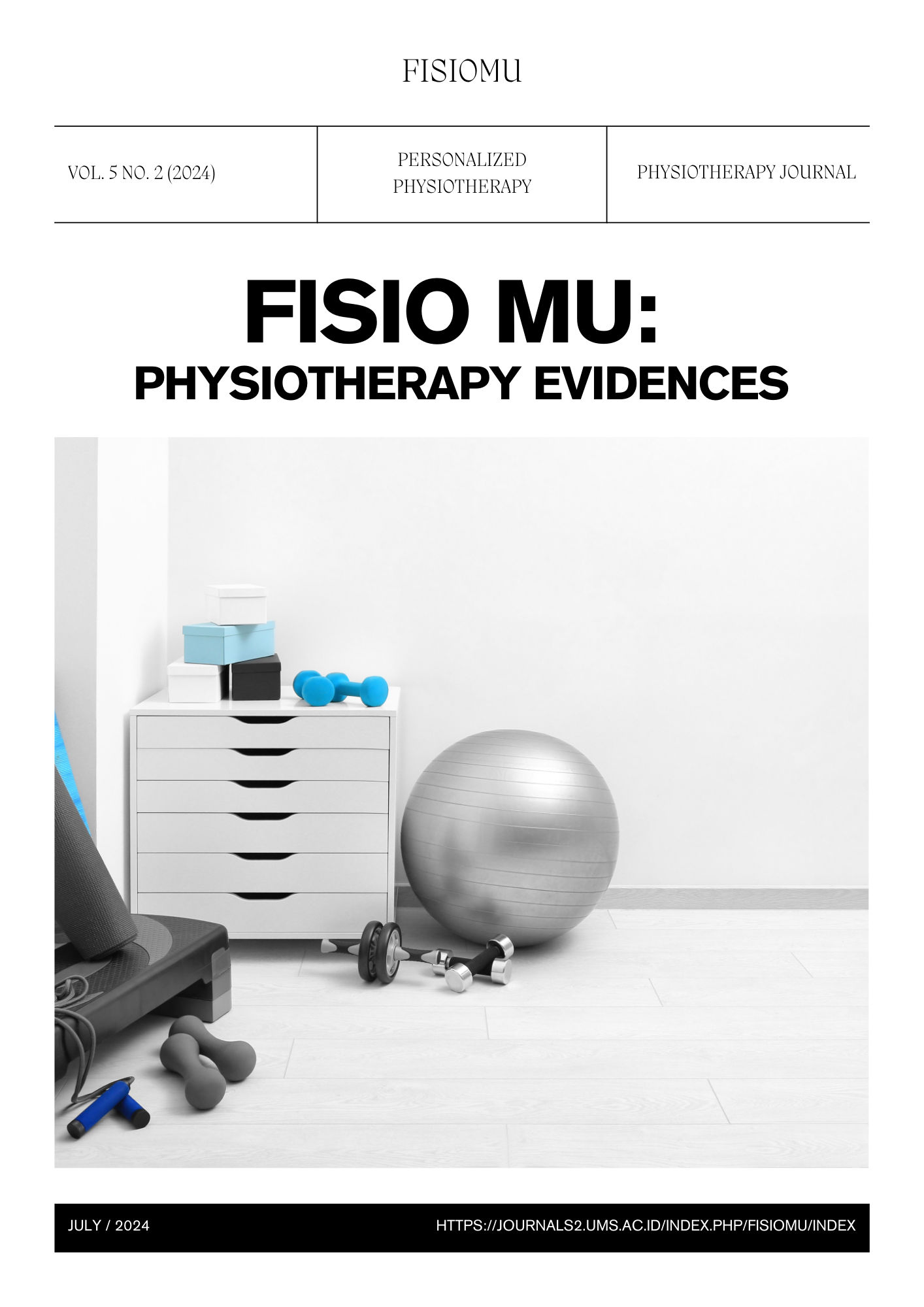Correlation between Flatfoot and Postural Balance in Children Aged 7-12 Years
DOI:
https://doi.org/10.23917/fisiomu.v5i2.4259Keywords:
flatfoot, postural balance, childrenAbstract
Flatfoot is characterized by a decrease or flattening of the medial longitudinal arch of the foot. Flatfoot in children in general can cause certain clinical manifestations. In general, the condition of flatfoot can also occur physiologically, which is then referred to as flexible flatfoot. Normally the arch of the foot is formed in the first five years of life at an age range of 2-6 years. The arch of the foot plays an important role in absorbing ground reaction forces and supporting the body's weight during activities.
The research design uses a cross-sectional study approach, which aims to find or study the relationship between flatfoot and balance in children aged 7-12 years. A total of 32 respondents aged 7-12 years who met the inclusion criteria were obtained through flatfoot examination using a wet footprint examination and balance examination using the Pediatric Balance Scale.
The results of the Pearson Correlation Test show a significance value of 0.031 (p<0.05) between the variables flatfoot and balance, which means there is a relationship between the condition of flatfoot and balance in children aged 7-12 years. The correlation coefficient value is 0.383, which means that the strength of the relationship between the two variables is quite strong with the direction of the relationship being positive, which means that the higher the degree of flatfoot in the child, the lower the child's balance.
Downloads
References
Abich, Y. et al. (2020) ‘Flatfoot and associated factors among Ethiopian school children aged 11 to 15 years : A school-based study’, 8, pp. 1–14. doi: 10.1371/journal.pone.0238001.
Article, O. (2015) ‘Correlation between the selective control assessment of lower extremity and pediatric balance scale scores in children with spastic cerebral palsy’.
Banwell, H. A. et al. (2018) ‘Paediatric flexible flat foot : how are we measuring it and are we getting it right ? A systematic review’, pp. 1–13.
Biomedika, J. et al. (2020) ‘Hubungan pes planus dan keseimbangan statis pada anak sekolah dasar’, 3(2), pp. 84–89. doi: 10.18051/JBiomedKes.2020.v3.84-89.
Carr, J. B., Yang, S. and Lather, L. A. (2016) ‘Pediatric pes planus: A stateofthe-art review’, Pediatrics, 137(3). doi: 10.1542/peds.2015-1230.
Curtin, B. et al. (2019) ‘Foot and Ankle Changes in Dynamic Plantar Pressure for Children with Tarsal Coalition as Compared to Normal Children’, 3(1), pp. 1–8.
De, I. et al. (2014) ‘Colombia Médica The impact of foot arch height on quality of life in 6-12 year olds’, 45, pp. 168–172.
Latifah, Y. et al. (2021) ‘Hubungan Antara Postur Flat Foot Dengan Keseimbangan Statis Pada Anak Usia 12 Tahun’, 2(1), pp. 1–6.
Medina-alcantara, M. et al. (2019) ‘Influence of Shoe Characteristics on the Development of Valgus Foot in Children’. doi: 10.3390/jcm8010085.
Mulyoto, R. R., Jannah, S. M. and Supinganto, A. (no date) ‘THE RELATIONSHIP BETWEEN FLATFOOT AND STATIC BALANCE IN SCHOOL-AGED CHILDREN’.
Nozaki, S. et al. (2020) ‘Annals of Anatomy Sex- and age-related morphological variations in the talar articular surfaces of the calcaneus’, Annals of Anatomy, 229, p. 151468. doi: 10.1016/j.aanat.2020.151468.
Park, J. Y. et al. (2020) ‘Effect of schroth rehabilitation exercise program on scoliome-ter readings, lumbar lordosis and calcaneal valgus angle in patients with idiopathic scoliosis’, Iranian Journal of Public Health, 49(4), pp. 808–809. doi: 10.18502/ijph.v49i4.3191.
Peng, Y. et al. (2020) ‘Immediate effects of medially posted insoles on lower limb joint contact forces in adult acquired flatfoot: A pilot study’, International Journal of Environmental Research and Public Health, 17(7). doi: 10.3390/ijerph17072226.
Romanova, E., Kolokoltsev, M. and Vorozheikin, A. (2022) ‘Original Article Comprehensive program for flat foot and posture disorders prevention by means of physical education in 6-year-old children’, 22(11), pp. 2655–2662.doi: 10.7752/jpes.2022.11337.
Sagat, P. et al. (2023) ‘Are flat feet a disadvantage in performing unilateral and bilateral explosive power and dynamic balance tests in boys ? A school- based study’, pp. 1–9.
Sativani, Z. et al. (2020) ‘Latihan Penguatan Kaki terhadap Keseimbangan Postural dan Kemampuan Fungsional Kaki pada Anak Usia 6-10 Tahun dengan Flexible Flatfoot’, 2(3), pp. 99–107.
Syafii, M., Pudjiastuti, S. S. and K., P. P. (2016) ‘Beda Pengaruh Arkus Kaki terhadap Keseimbangan Statis Anak Usia 9-12 Tahun di SD Negeri Mojolegi, Teras, Boyolali’, Jurnal Kesehatan, 7(3), p. 351. doi: 10.26630/jk.v7i3.215.
Traumatologia, D. O. E. and Castrovillari, O. Di (2023) ‘Flat Foot in the Children : a Review of Literature ( Expert Opinion ) Journal of Pediatrics & Neonatal Biology’, 8(1), pp. 145–150.
Uden, H., Scharfbillig, R. and Causby, R. (2017) ‘The typically developing paediatric foot : how flat should it be ? A systematic review’, pp. 1–17. doi: 10.1186/s13047-017-0218-1.
Xu, L. et al. (2022) ‘Risk Factors of Flatfoot in Children : A Systematic Review and Meta-Analysis’.
Downloads
Submitted
Accepted
Published
How to Cite
Issue
Section
License
Copyright (c) 2024 Fisio Mu : Physiotherapy Evidaces Journal

This work is licensed under a Creative Commons Attribution-NonCommercial-NoDerivatives 4.0 International License.

This work is licensed under a Creative Commons Attribution-NonCommercial 4.0 International License.
Authors who publish with FISIO MU: Phsiotherapy Evidences agree to the following terms:
- Author(s) retain copyright and grant the journal right of first publication with the work simultaneously licensed under a Creative Commons Attribution-NonCommercial 4.0 International License that allow others to share the work within an acknowledgement of the work’s authorship and initial publication of this journal.
- Author(s) are able to enter into separate, additional contractual arrangement for the non-exclusive distribution of the the journal’s published version of the work (e.g. acknowledgement of its initial publication in this journal).
- Author(s) are permitted and encouraged to post their work online (e.g. in institutional repositories or on their websites) prior to and during the submission process, as it can lead to productive exchanges, as well as earlier and greater citation of published works.









